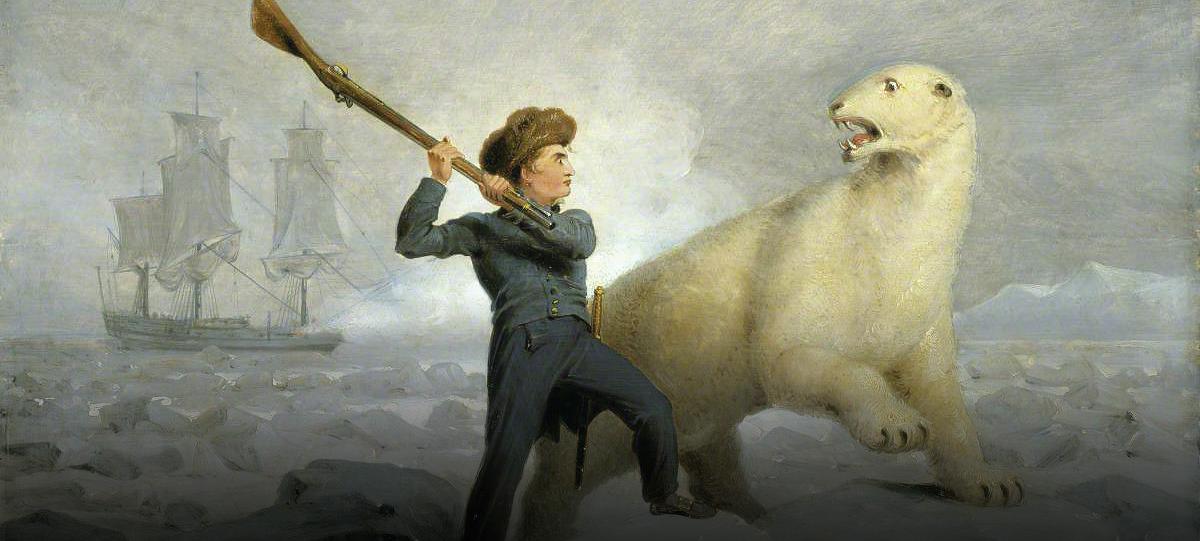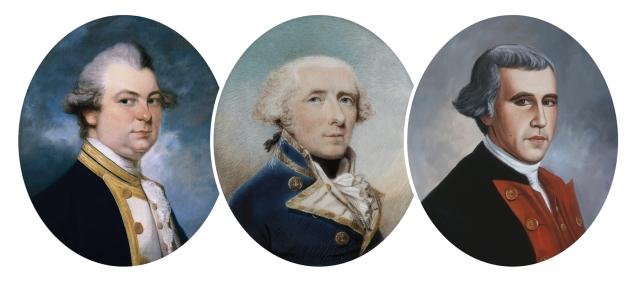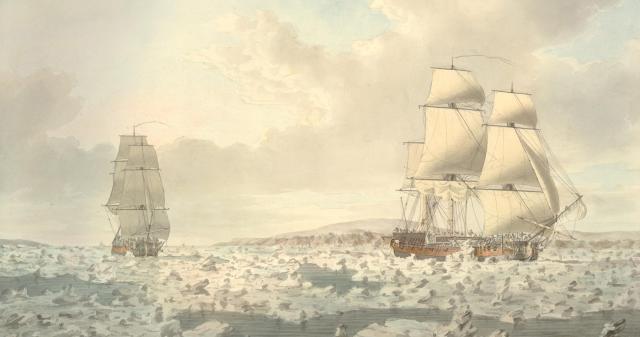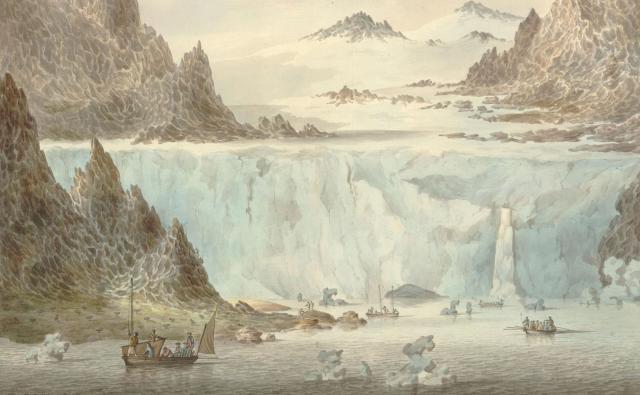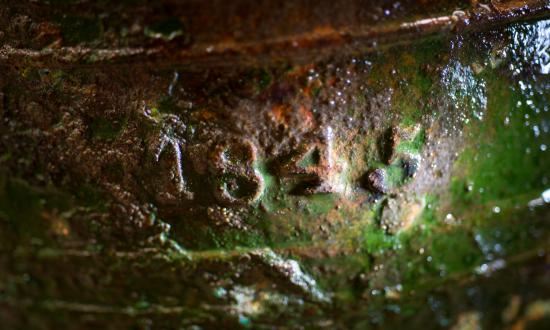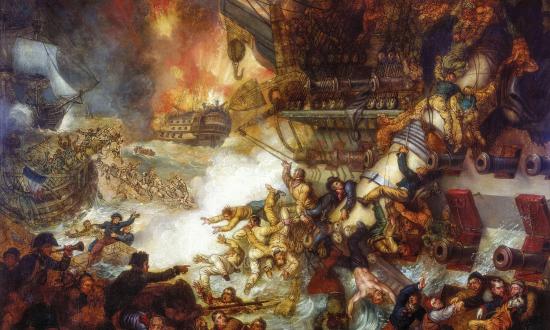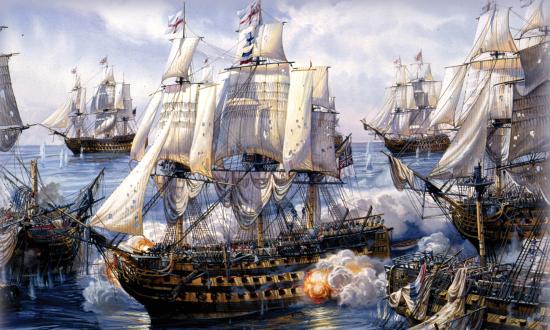In the early 1770s, there were few opportunities for British naval personnel to distinguish themselves in action. Aside from a near-crisis with Spain over the Falkland Islands in 1770, Great Britain enjoyed a rare decade of peace. As the Royal Navy was reduced, many officers and seamen sought employment in the merchant service or jockeyed for the few naval billets available. Occasionally, voyages of scientific discovery (such as Captain James Cook’s 1768–71 expedition to Tahiti and Australia) offered employment for naval personnel in unexpected directions.
The theory that a passage across the North Pole by water existed was proposed as early as 1527. A handful of 17th-century expeditions explored the waters around Greenland and Spitsbergen (part of the Svalbard archipelago), but rarely were they able to penetrate past 80° north. Several European countries subsequently established a profitable whaling industry in the area.1
By 1773, curiosity about the polar region had only grown: “The figure of the earth, the phenomena of the winds, the variation of the compass, and the attraction of the magnet, are points yet unsettled, of infinite importance to navigation; and it is not impossible, but that a more careful examination of the polar regions may lead to the solution of problems that have hitherto baffled the enquiries of the ablest navigators.”2
Based on the theory of Swedish geographer Samuel Engel, who suggested that ice was formed primarily from fresh water adjacent to land and could be bypassed by sailing farther from the coast, Daines Barrington of the Royal Society suggested in a letter to the First Lord of the Admiralty that a naval expedition be undertaken to the North Pole. The First Lord forwarded the proposal to King George III. In February 1773, the king directed that the voyage “should be immediately undertaken, with every encouragement that could countenance such an enterprize, and every assistance that could contribute to its success.”3
Ready for Every Contingency
On 19 April 1773, Constantine Phipps of the Royal Navy was appointed to HMS Racehorse and overall command of the expedition as commodore, while Captain Skeffington Lutwidge was assigned to the consort HMS Carcass. The Racehorse and Carcass were bomb vessels designed to withstand the shock of firing large mortars; their hulls were doubled and their bows fortified to increase their durability against repeated collisions with ice. Their complements were limited to 90 men each, giving either the capacity to hold both crews should a single ship be lost, and enough boats were provided to carry the entire expedition if both vessels were abandoned. There was even a store of bricks and mortar taken aboard to build a shelter if the crews were trapped on land.4
The Admiralty ordered that beef and pork be butchered and preserved specifically for the expedition’s use, so provisions would be as fresh as possible. Some 10,800 gallons of porter were provided, along with a quantity of brandy “to be issued at the discretion of the commanders, when extraordinary fatigue or severity of weather might make it expedient,” Phipps recounted. “A quantity of wine was also allotted for the use of the sick. Additional clothing, adapted to that rigor of climate . . . we were taught to expect, was ordered to be put on board, to be given to the seamen when [they] arrived in the high latitudes.”5
Only experienced sailors were assigned to the expedition, and Phipps and Lutwidge were permitted to select their own officers. As no warranted sailing masters in the Royal Navy familiar with circumpolar waters could be found, whalers with previous experience near Greenland were hired as pilots. Among the crew assigned to the Carcass were two midshipmen billeted as coxswains: the future Vice Admiral Horatio Lord Nelson and Nicholas Biddle, who later served to great effect in the Continental Navy. Dr. Charles Irving, noted for developing a means of distilling drinkable water from the sea, joined the crew of the Racehorse as surgeon. He was accompanied by Olaudah Equiano, a former slave and future British abolitionist.
The Royal Society appointed Israel Lyons to accompany the expedition “to make nautical and astronomical observations.”6 Among the many instruments taken on the expedition were a chronometer constructed by Larcum Kendall based on John Harrison’s design, multiple log reels used to measure a ship’s speed, megameters and quadrants to aid in surveying and navigation, and a new thermometer designed to measure the temperature of ocean water at great depth.
The Racehorse and Carcass were furnished with extra anchors, cables, sails, rigging, and ice poles to better prepare for operating in the Arctic. “In short,” recalled Phipps, “every thing which could tend to promote the success of the undertaking, or contribute to the security, health, and convenience of the ships’ companies, was granted.”7
According to Phipps’ orders dated 25 May 1773, the Racehorse and Carcass were to proceed north to the waters between Greenland and Spitsbergen and keep to the open water to avoid any fresh water that emptied into the sea. They also were to sail as nearly upon a single meridian as possible, to aid Lyons in testing various instruments. Should the ships reach the North Pole, they were not to cross into the opposite hemisphere, but rather determine how far navigation was practicable to the west of Spitsbergen. In all events, the Racehorse and Carcass were to return home before the advancing season could obstruct their passage.8
After fitting out in separate locations, the two vessels rendezvoused at the Nore on 30 May. Contrary winds made for slow progress out of the Thames Estuary, but by 15 June, the Racehorse and Carcass had passed into the Norwegian Sea.
Ice, Polar Bears, and Walrus
For the first two weeks of the long journey north, the expedition passed the time conducting experiments and making observations. Phipps tested the accuracy of two log reels (used to measure speed by counting evenly spaced knots as a line pays out from a ship under way); a log with 45 feet between knots was used to estimate the ship’s position to within two nautical miles, while the more commonly used 51-foot log was off by 43 nautical miles. By 19 June, the expedition was far enough north that Commodore Phipps took a sighting of the sun at midnight, determining their latitude to be 66°54’39” north. The following day, Phipps recorded a water temperature of 26 degrees Fahrenheit at a depth of 780 fathoms. The crews also began use of Dr. Irving’s distillation machine, producing between 34 and 40 gallons of fresh water per day.9
On the evening of 30 June, as the Racehorse and Carcass were making observations along the southwest coast of Spitsbergen, they met with a ship from Greenland. Her captain informed Commodore Phipps that his ship recently came through the ice some 16 leagues west. With this news, the ships bore away from the land and continued north. On 5 July, one expedition member wrote, “A dreadful crackling was heard at a distance, which proved the dashing and grinding of the loose pieces of ice against each other, which is heard at many leagues distance.”10
The crews heard surf breaking on shore, and the Racehorse and Carcass soon came to a large body of ice that stretched nearly as far as they could see. “The wind blowing fresh, the ships would have been in danger on the lee ice, had not the officers and men been very alert in working the ship.”11 No passage to the north was found, so the ships cruised the waters northwest of Spitsbergen to seek openings there. Phipps had the Racehorse sail through loose ice close to the main body, hoping to take advantage of any openings that appeared.
On the evening of 25 July, the Carcass was becalmed off Moffen Island, just to the northeast of Spitsbergen. Captain Lutwidge sent a boat ashore to explore the island, which was apparently a popular nesting site for ducks, geese, and other Arctic fowl. Polar bears and walrus are found on the island as well; at one point, “Major Buz,” the officer in charge of the landing party, “filled his breeches” after falling while escaping a charging polar bear, much to the delight of his shipmates.12
The major was not the last to come face to face with the local fauna. According to British naval legend, Midshipman Nelson left the Carcass without permission to hunt a polar bear and bring the skin home to his father. When Nelson finally met with his quarry, his musket misfired, and the timely opening of a crevasse in the ice prevented his mauling and early death. While some attributed the story to Captain Lutwidge, there is little documentary evidence to verify this episode took place.13
It seems that other Arctic wildlife may have given the young Nelson his first taste of combat, however. Commodore Phipps described an incident that took place as one of the Racehorse’s boats returned from the survey of a nearby island: “In their way back they had fired at, and wounded a sea-horse [an “Arctick Walrus” according to the appendix], which dived immediately, and brought up with it a number of others. They all joined in an attack on the boat, wrested an oar from one of the men, and were with difficulty prevented from staving or oversetting her; but a boat from the Carcass joining ours, they dispersed.” The boat from the Carcass, according to historian Ann Savours, was commanded by Nelson and apparently arrived in the nick of time, as the walruses repeatedly punctured the boats with their tusks. The boat crews escaped but were unable to inflict any serious damage on the beasts during the unorthodox engagement.14
Phipps “now began to conceive that the ice was one compact impenetrable body, having run along it from East to West above ten degrees.” The ships turned into any opening that appeared, usually finding these to be only a mile or two in length. Wind and current frequently packed the ice in close around the ships, threatening to freeze them in place. On 29 July, Phipps reported that the Racehorse “struck very hard against the ice in getting the ship round, and got upon one piece, which lifted her in the water for near a minute, before her weight broke it. The ships had been so well strengthened, that they received no damage from these strokes.”15
The Racehorse and Carcass then approached the Seven Islands, a small chain at the northernmost reaches of the Svalbard archipelago. As recorded by Phipps, “Amongst the islands, I saw much ice, but also much water between the pieces; which gives me hope that when a breeze sprung up, I should be able to get to the Northward by that way.”16 He couldn’t know this would be the scene of the expedition’s most desperate episode.
The Expedition Beset
On 30 July, the two vessels got among the islands and promptly lost their wind. They moored alongside an ice field, becalmed in a large bay surrounded by loose ice. The Racehorse’s sailing master was sent to high ground ashore to determine the state of the surrounding ice. “They had ascended an high mountain, from where they commanded a prospect extending to the East and North East ten or twelve leagues, over one continued plain of smooth unbroken ice, bounded only by the horizon.”17
Light easterly winds for the next two days allowed the ships to move a short distance, but loose ice closed in when this wind died. The crews refilled their water casks from the nearby snow and spent the rest of the day playing on the ice. Meanwhile, the Greenland pilots became increasingly nervous about their situation; they were farther out than they had ever been, and as the season advanced, the ships easily could have become trapped in the accumulating ice.18
On 1 August, currents set the loose ice drifting east, away from open water. The ice packed steadily closer, some forced higher than the Racehorse’s main yard by currents and pressure. The Racehorse and Carcass were forced to within two lengths of one another with no room to turn. The men were set to work carving a proper dock in the ice to give the ships a more stable mooring.19
As currents drove the ships farther east on 3 August, Phipps had both ships’ companies begin sawing through ice—more than 12 feet thick in some places—to open a passage for the ships. The Carcass was made fast to the stern of the Racehorse throughout the process. Despite a full day’s labor, the ships gained only 300 yards of westward movement, a pittance compared with the distance drifted in the wrong direction. On the 5th and 6th, a party under the Racehorse’s Midshipman Walden was dispatched to the northernmost of the islands 12 miles away to reconnoiter the surrounding area. Walden reported open water and favorable winds . . . if only the ships could get there. Unfortunately, the Racehorse and Carcass were now being driven into shoal water and stood a good chance of being run aground and crushed.20
The expedition’s predicament started to seem inescapable. Commodore Phipps reasoned that if the crews were to attempt wintering in the Seven Islands, the ships would not likely be serviceable, nor would the surviving crew be in any condition to undertake a long voyage the next summer. The alternative was to take to the boats, drag them across the ice to open water, and sail to Spitsbergen in the hopes of finding a whaler to convey the people home. A detachment of 50 men was drawn from each ship for this purpose. Phipps was to lead the boat parties while Captain Lutwidge remained with the ships.21
Phipps and several officers led their detachment onto the ice on 7 August. Midshipman Nelson was assigned 12 men to begin fitting out the Carcass’ four-oared cutter, building up the sides with spare timber and canvas to afford the crew better protection from the elements. Over the next two days, the boats were hauled five miles across the ice, with the men in relatively high spirits; Phipps’ crew boastfully hauled for the honor of their commodore, while one of the other officers had music played to sweeten the work. The ice was starting to drift and carry the ships back toward the west, and Phipps estimated that it would take until the 14th to haul the boats to the water. If the Racehorse and Carcass were not clear by that point, he resolved to leave them behind.22
On the morning of 9 August, an easterly wind sprang up and finally allowed the ships to get under way. The Carcass was cast loose from the Racehorse, and both ships quickly set sail. The ships soon overtook the boats, which were taken aboard that afternoon. Even when the ships were halted again in heavy snow, Phipps believed just one more favorable wind would free them.23
Early on the 10th, such a wind sprang up, and the ships set all sail to force through the remaining ice. “Every officer and every idler on board laboured now for life.” The reinforced hulls struck hard again and again against the ice. After hours of rough sailing, the Racehorse and Carcass made it into open water around noon. Relieved to have put the Seven Islands astern, they cruised between the main body of ice and northern Svalbard the remainder of the day.24
Homeward Bound
On 11 August, the Racehorse and Carcass anchored in the harbor of Smeerenburg, the site of an abandoned Dutch whaling settlement in northwest Spitsbergen. They remained there for eight days, “to refresh the people from their fatigues.” Several ovens were taken on shore, and a “considerable quantity of good soft bread” was prepared for the men. Soon enough, they were set to work overhauling rigging, tarring the sides, and otherwise refitting the ships for the next stage of their voyage.
While there, Phipps gave a detailed description of a nearby “iceberg,” later identified as the glacier Kennedybreen: “That represented in the engraving . . . was about three hundred feet high, with a cascade of water issuing out of it. The black mountains, white snow, and beautiful color [a ‘very lively light green’] of the ice, make a very romantick and uncommon picture.”25
The expedition departed on 19 August, with Commodore Phipps still determined to push to the north. They reached the main body of ice, but thick fog and increasingly hostile winds prevented the ships from penetrating onward. By the 22nd, Phipps decided the expedition wouldn’t get any farther. He ordered a course set for home, hoping to avoid the worst of the frequent fogs and heavy gales that characterized autumn in Arctic waters.26
The return voyage began mildly enough. On 4 September, Phipps measured the depth of water between Iceland and Norway at some 683 fathoms; it took the crew a full eight hours to haul the lead in afterward.27 From the 7th until the 24th, however, the expedition was plagued by constant gales and rough seas. The Racehorse lost three boats and was forced to throw two guns overboard to remain afloat, while the Carcass was nearly waterlogged from the weight of water washing over her decks. Fortunately, the ships came through the foul weather safely and anchored at Deptford by 30 September.28
A Successful Failure
According to Olaudah Equiano, “Thus ended our Arctic voyage, to the no small joy of all on board, after having been absent four months; in which time, at the imminent hazard of our lives, we explored nearly as far towards the Pole as 81 degrees north, and 20 degrees east longitude; being much farther . . . than any navigator had ever ventured before; in which we fully proved the impracticability of finding a passage that way to India.”29
“I do not intend to go to Greenland again,” Nicholas Biddle wrote to his sister in mid-October, “. . . for you must know I have been . . . so terrified at hearing of the . . . Dreadfull dangers we were in that I am positive my hand shakes while I write and what astonishes confounds and frightens me most of all is that during the whole Voiage I did not aprehend danger.”30
Upon their return, news of the expedition quickly spread throughout Europe. An anonymous journal of the expedition (likely written by the Carcass’s surgeon, William Wallis) was published in February 1774, with Phipps’ journal released later that year. The latter contains more than 70 pages of narrative of the voyage itself, an appendix nearly twice as long detailing the various experiments and observations made, and an extensive catalogue of the flora and fauna encountered along the way.31
Among these is the first scientific description of the polar bear and documentation of Phipps’ discovery of the ivory gull. An effective salve for failing to reach the North Pole, the sheer amount of scientific data brought back by Phipps and company was praised just as highly as their bravery in pursuing the expedition. Particularly vindicating had to be the fact of “the Crews of both Vessels being in perfect Health, owing most probably to the extraordinary Precautions taken in that Respect.”32
The Phipps Expedition left a lasting impression on the men who undertook it. Observing the actions of Captains Phipps and Lutwidge gave the future Captain Biddle and Lord Nelson a poignant lesson in how naval leaders should conduct themselves under arduous circumstances. While the expedition brought little glory to those who participated, it gathered a wealth of scientific data on the Arctic environs. If a sea route across the North Pole had been discovered, it would have meant profound economic and military advantages for Great Britain. Seeking those out and increasing Britain’s scientific knowledge were excellent ways for the Royal Navy to provide valuable peacetime service.
1. Ann Savours, “A Very Interesting Point in Geography: The 1773 Phipps Expedition towards the North Pole,” Arctic 37, no. 4 (December 1984): 402.
2. Anonymous, The Journal of a Voyage Undertaken by Order of His Present Majesty for Making Discoveries Towards the North Pole (London: Newbery, 1774), 106.
3. Constantine John Phipps, A Voyage Towards the North Pole Undertaken by His Majesty’s Command, 1773 (London: Bowyer and Nichols, 1774), 10.
4. Savours, “A Very Interesting Point in Geography,” 404.
5. Anonymous, Journal of a Voyage, xxvii; Phipps, A Voyage Towards the North Pole, 11.
6. Savours, “A Very Interesting Point in Geography,” 408.
7. Phipps, A Voyage Towards the North Pole, 12.
8. Savours, “A Very Interesting Point in Geography,” 409.
9. Phipps, A Voyage Towards the North Pole, 24–28.
10. Phipps, 33; Anonymous, Journal of a Voyage, 38.
11. Phipps, A Voyage Towards the North Pole, 36.
12. Anonymous, Journal of a Voyage, 61.
13. Roger Knight, The Pursuit of Victory: The Life and Achievement of Horatio Nelson (New York: Basic Books, 2005), 32.
14. Phipps, A Voyage Towards the North Pole, 57–58; Anonymous, Journal of a Voyage, 51; Savours, “A Very Interesting Point in Geography,” 416.
15. Phipps, A Voyage Towards the North Pole, 42, 50.
16. Phipps, 59.
17. Phipps, 60.
18. Phipps, 61; Anonymous, Journal of a Voyage, 66.
19. Phipps, A Voyage Towards the North Pole, 61; Anonymous, Journal of a Voyage, 69.
20. Phipps, A Voyage Towards the North Pole, 62–65; Anonymous, Journal of a Voyage, 76; Savours, “A Very Interesting Point in Geography,” 418.
21. Phipps, A Voyage Towards the North Pole, 64; Anonymous, Journal of a Voyage, 77.
22. Phipps, A Voyage Towards the North Pole, 65–66; Anonymous, Journal of a Voyage, 78; Savours, “A Very Interesting Point in Geography,” 418–19.
23. Phipps, A Voyage Towards the North Pole, 67–68; Savours, “A Very Interesting Point in Geography,” 419–20.
24. Anonymous, Journal of a Voyage, 82. Phipps, A Voyage Towards the North Pole, 68.
25. Phipps, A Voyage Towards the North Pole, 68, 70, 87. Anonymous, Journal of a Voyage, 89. Savours, “A Very Interesting Point in Geography,” 421.
26. Phipps, A Voyage Towards the North Pole, 73–74.
27. Anonymous, Journal of a Voyage, 92.
28. Phipps, A Voyage Towards the North Pole, 73; Anonymous, Journal of a Voyage, 101; Savours, “A Very Interesting Point in Geography,” 421.
29. Olaudah Equiano, The Interesting Narrative and Other Writings (New York: Penguin Books, 1995), 177.
30. William Bell Clark, “The Letters of Captain Nicholas Biddle,” The Pennsylvania Magazine of History and Biography 74, no. 3 (July 1950): 373.
31. Savours, “A Very Interesting Point in Geography,” 426.
32. “London, July 25,” Virginia Gazette, 9 December 1773.



